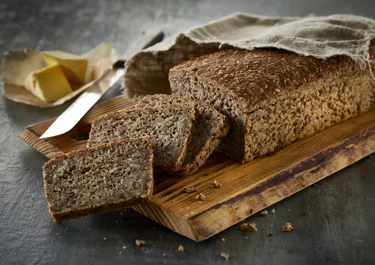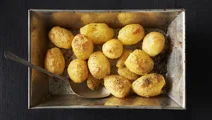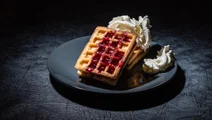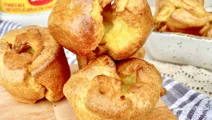Danish rye bread

Have you always wanted to try your hand at making classic rye bread? With our easy Danish rye bread recipe there is no excuse not to go for it. You get a homemade loaf full of delicious seeds and grains that is quick and easy to make. Our Danish rye bread has a complex flavour profile with malty, tangy, and subtle nutty flavours that taste great with a never-ending selection of toppings.
Ingredients
|
Cracked rye berries (approx. 4 dl)
|
300 g |
|---|---|
|
Boiling water
|
500 ml |
|
Yeast
|
25 g |
|
Lukewarm water
|
300 ml |
|
Buttermilk
|
400 ml |
|
Beer, for instance, a porter or another dark beer
|
200 ml |
|
Wheat flour (approx. 11 dl)
|
500 g |
|
Rye flour (approx. 3¾ dl)
|
250 g |
|
Flaxseed (approx. 3 dl)
|
200 g |
|
Sunflower seeds (approx. 2½ dl)
|
150 g |
|
Sesame seeds (approx. 2 dl)
|
125 g |
|
Coarse salt
|
2 tbsp |
Instructions
Tips
If you are wondering how to make Danish rye bread delicious and moist, the answer is proper proofing. While under-proofing may result in cracked rye bread, over-proofing may give it a hard crust and slightly, mushy centre or cause the rye bread to collapse as it bakes. The best way to tell if a rye bread dough has been proofed properly is to use your eyes rather than your timer. When the dough is done proofing for a second time, small holes about the size of a pin head will form on its surface. When the surface sports about 6-7 of these holes, it is ready to be baked.
Tips
If you have the time, let the cracked rye berries soak for 24 hours instead of just 1 hour. This will make it even better.
Questions about Danish rye bread
With our easy Danish rye bread recipe, making rye bread from scratch is quite simple. Below, you can learn a bit more about what rye bread is and how it is best stored by reading our answers to some of the most frequently asked questions about the traditional Danish treat.
What is a Danish rye bread?
How to make Danish rye bread?
Can you freeze Danish rye bread?
How long is Danish rye bread good for?
Traditional Danish rye bread
Rye bread is known and loved for its dark-brown colouring, deep flavours, and sturdy, yet soft, texture. The dark and dense bread type is popular throughout most Scandinavian countries and has been so since at least the Middle Ages. In Denmark, many people eat rye bread daily – as a hearty breakfast, a classic lunch, or a quick and easy dinner – and some Danes will even make space to pack a loaf of rye bread when they go on a long vacation. Try our recipe for Danish rye bread to see what the fuss is about.
Enjoy its tangy and malty flavour
Compared to classic white bread or more textured wholemeal bread, Danish rye bread has an earthier, tangier flavour and a much denser crumb. Rye gives the bread type a complex, slightly sour flavour that is beautifully rounded off by the addition of dark beer. Using buttermilk and beer is a great and easy way of ensuring that homemade baked goods are moist. While the beer's alcohol evaporates as the bread bakes, it leaves behind plenty of acidity as well as a sweet, malty deliciousness.
Use it for Danish open-faced sandwiches
Keeping it simple and topping Danish rye bread with a slice of your favourite cheese or cold cut tastes great, but you will not regret going all out and making smørrebrød. The Danish name of the classic open-faced sandwich literally translates to "butter bread" and the sandwiches are made by buttering a single piece of hearty rye bread and topping it with a piece of lettuce and a generous helping of different toppings.
Iconic topping combinations for Danish rye bread include roast beef with remoulade, horseradish, pickles, and roasted onions; eggs and shrimp with mayonnaise, tomato, garden cress, caviar, and a slice of lemon; pork roast with crispy pork crackling, pickled red cabbage, pickles, and a slice of orange; and pâté with roasted mushrooms, bacon, and pickled beetroot. There are so many versions of Danish open-faced sandwiches that you are sure to find a lot of tasty new favourites.
Danish rye bread bursting with seeds and grains
Traditional Danish rye bread is a fibrous bread packed with different seeds and grains that come together to create a chewy crumb with a lot of texture. The classic combination of linseeds, sunflower seeds, and sesame seeds is tasty and gives Danish rye bread a subtle earthy and nutty flavour that adds a delicious richness. The cracked rye berries have a slightly sweet and fruity flavour that complements the maltiness and subtle buttery flavour of the beer beautifully while giving the bread an interesting texture.
Try using sourdough instead of yeast
Traditional Danish rye bread can also be made using sourdough rather than yeast as the leavening agent. Using sourdough introduces an acidic aroma that plays up the dark bread's natural tanginess and complements its malty sweetness. In addition, sourdough rye bread has a longer shelf life than yeasted one. Once you have your own sourdough starter going you can use it to make sure you always have freshly baked loaves of Danish rye bread or airy and crispy sourdough bread on hand to make easy and delicious meals.






